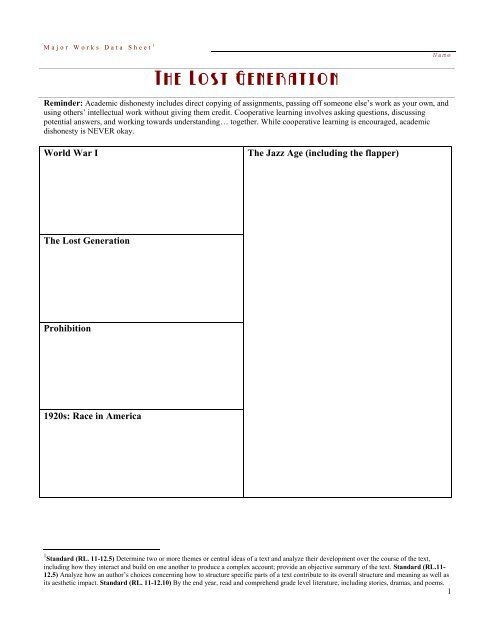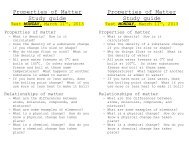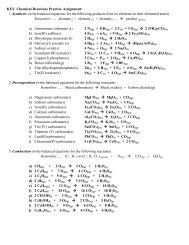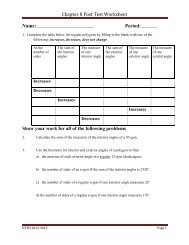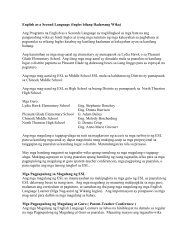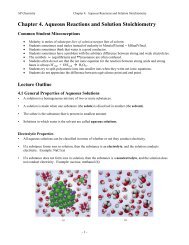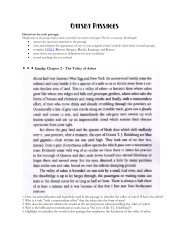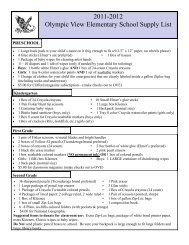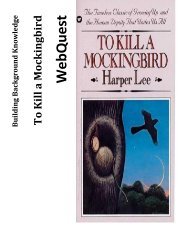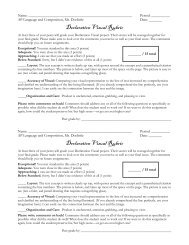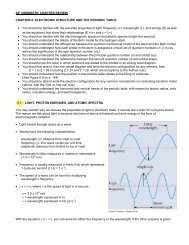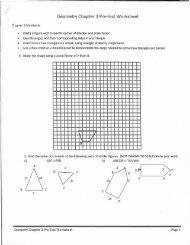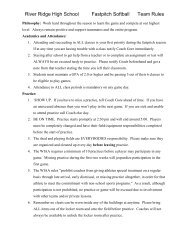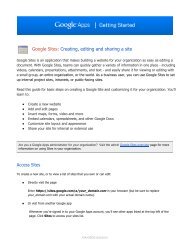Major Works Data Sheet
Major Works Data Sheet
Major Works Data Sheet
You also want an ePaper? Increase the reach of your titles
YUMPU automatically turns print PDFs into web optimized ePapers that Google loves.
M a j o r W o r k s D a t a S h e e t 1<br />
The Lost Generation<br />
Name<br />
Reminder: Academic dishonesty includes direct copying of assignments, passing off someone else’s work as your own, and<br />
using others’ intellectual work without giving them credit. Cooperative learning involves asking questions, discussing<br />
potential answers, and working towards understanding… together. While cooperative learning is encouraged, academic<br />
dishonesty is NEVER okay.<br />
World War I<br />
The Jazz Age (including the flapper)<br />
The Lost Generation<br />
Prohibition<br />
1920s: Race in America<br />
1 Standard (RL. 11-12.5) Determine two or more themes or central ideas of a text and analyze their development over the course of the text,<br />
including how they interact and build on one another to produce a complex account; provide an objective summary of the text. Standard (RL.11-<br />
12.5) Analyze how an author’s choices concerning how to structure specific parts of a text contribute to its overall structure and meaning as well as<br />
its aesthetic impact. Standard (RL. 11-12.10) By the end year, read and comprehend grade level literature, including stories, dramas, and poems.<br />
1
Francis Scott Fitzgerald<br />
Ernest Hemingway<br />
How his life<br />
influenced<br />
his work<br />
relations<br />
with women<br />
death<br />
career<br />
highlights<br />
What was the relationship between the two<br />
When they met, Fitzgerald = famous. Hemingway = nobody. They were friends, and F helped H. The more famous H<br />
got, the less he admired F.<br />
Both expatriates living in Paris<br />
Hemingway called Fitzgerald “a drunk, a weakling, a hypochondriac, a fool, an irresponsible writer, a nuisance,<br />
sexually insecure and wife-dominated…” 2<br />
H on F: “I never had any respect for him ever except for his lovely, golden, wasted talent.” 3<br />
2 Matthew J. Bruccoli, Fitzgerald and Hemingway: A Dangerous Friendship (New York: Carroll & Graf, 1995) 1.<br />
3 Ibid, 215<br />
2
(1) Exposition<br />
Setting (Time/Place) Main characters<br />
Gatsby Plot Summary<br />
(4) Falling Action<br />
What is the outcome of the climax<br />
(Chronological order)<br />
(2) Rising Action<br />
What is the conflict What are some of the events that<br />
seem to make things worse<br />
(Please provide events in chronological order.)<br />
(3) Climax<br />
What happens during the point of<br />
greatest tension (Note: this is always<br />
a scene.)<br />
(5) Resolution<br />
How does it all work out (or<br />
not) at the end<br />
3
Subject List<br />
(Remember, a subject is an abstract noun. Think of this as a big idea topic,<br />
like “love” or “identity.”) You need at least seven.<br />
By F. Scott Fitzgerald<br />
The Great Gatsby<br />
Published in 1925 to some of the best reviews of Fitzgerald’s<br />
career<br />
Considered the definitive Jazz Age novel:<br />
Potential Themes<br />
(Remember, a theme is the author’s bigger message about life. Your theme<br />
should be a complete sentence. It should include an abstract noun from<br />
above. It should NOT include specifics about plot or character. Example:<br />
“Love conquers all.”)<br />
You need at least five.<br />
Significance of the Opening Scene<br />
Significance of the Closing Scene<br />
4
Gatsby Setting: Remember that setting involves both the where and the when. Give me several significant quote descriptors for each place. Compare<br />
and contrast the places. Discuss what the places might signify on a deeper level and why certain action does (or does not) take place in these locales.<br />
East Egg West Egg Valley of Ashes<br />
Great Gatsby Characters<br />
Please attach your character map to this <strong>Major</strong> <strong>Works</strong> <strong>Data</strong> <strong>Sheet</strong>. Your character map should cover Tom, Daisy, Nick, Gatsby, Jordan,<br />
Myrtle, and George. Include:<br />
Names of the characters<br />
Brief blurbs to describe characters’ main function or behavior in the story.<br />
Pictures and names of the actors you’ve chosen to play the characters in a movie.<br />
Plausible choice of actors.<br />
Coded arrows to show relationships (friendships, marriages, family, and romance)<br />
A key to show what the arrows mean<br />
<br />
<br />
<br />
Great Gatsby: Significant Quotes and Author’s Style<br />
Please attach all of your passage analysis work (passages arranged in chronological order)<br />
Please also attach all of your lecture notes, as well as your Gatsby Discussion Board rubric.<br />
Please also attach your Blue Book Exam essay.<br />
<br />
<br />
<br />
Hemingway: Significant Quotes and Author’s Style<br />
Please attach all of your lecture notes.<br />
Please also attach your Code Hero notes for Hills Like White Elephants, A Clean, Well-Lighted Place, and Soldier’s Home.<br />
Please also attach your Blue Book Exam quote identification.<br />
5
12 th grade AP Literature Exam: Question 3<br />
The Great Gatsby<br />
Directions: As a senior taking the AP Literature exam, one of your essay prompts will be the infamous “open question.” This<br />
prompt (it’s always #3 on the test) presents you with a broad concept or theme; you must—from memory!—analyze how a<br />
quality work of literature typifies that concept or theme. Great Gatsby is applicable to all of the following prompts, which<br />
come from past AP exams. Be prepared to outline and/or write any of the following essays.<br />
* * * * *<br />
1982. In great literature, no scene of violence exists for its own sake. Choose a work of literary merit that confronts the reader or audience<br />
with a scene or scenes of violence. In a well-organized essay, explain how the scene or scenes contribute to the meaning of the complete<br />
work. Avoid plot summary.<br />
1983. From a novel or play of literary merit, select an important character who is a villain. Then, in a well-organized essay, analyze the<br />
nature of the character’s villainy and show how it enhances meaning in the work. Do not merely summarize the plot.<br />
1988. Choose a distinguished novel or play in which some of the most significant events are mental or psychological; for example,<br />
awakenings, discoveries, changes in consciousness. In a well-organized essay, describe how the author manages to give these internal<br />
events the sense of excitement, suspense, and climax usually associated with external action. Do not merely summarize the plot.<br />
1991. Many plays and novels use contrasting places (for example, two countries, two cities or towns, two houses, or the land and the sea) to<br />
represent opposed forces or ideas that are central to the meaning of the work. Choose a novel or play that contrasts two such places. Write<br />
an essay explaining how the places differ, what each place represents, and how their contrast contributes to the meaning of the work.<br />
1992. In a novel or play, a confidant (male) or a confidante (female) is a character, often a friend or relative of the hero or heroine, whose<br />
role is to be present when the hero or heroine needs a sympathetic listener to confide in. Frequently the result is, as Henry James remarked,<br />
that the confidant or confidante can be as much “the reader’s friend as the protagonist’s.” However, the author sometimes uses this<br />
character for other purposes as well. Choose a confidant or confidante from a novel or play of recognized literary merit and write an essay<br />
in which you discuss the various ways this character functions in the work.<br />
1997. Novels and plays often include scenes of weddings, funerals, parties, and other social occasions. Such scenes may reveal the values<br />
of the characters and the society in which they live. Select a novel or play that includes such a scene and, in a focused essay, discuss the<br />
contribution the scene makes to the meaning of the work as a whole.<br />
2002. Morally ambiguous characters—characters whose behavior discourages readers from identifying them as purely evil or purely<br />
good—are at the heart of many works of literature. Choose a novel or play in which a morally ambiguous character plays a pivotal role.<br />
Then write an essay in which you explain how the character can be viewed as morally ambiguous and why his or her moral ambiguity is<br />
significant to the work as a whole. Avoid mere plot summary.<br />
2004. Critic Roland Barthes has said, “Literature is the question minus the answer.” Choose a novel, or play, and, considering Barthes’<br />
observation, write an essay in which you analyze a central question the work raises and the extent to which it offers answers. Explain how<br />
the author’s treatment of this question affects your understanding of the work as a whole.<br />
2007. In many works of literature, past events can affect, positively or negatively, the present activities, attitudes, or values of a character.<br />
Choose a work in which a character must contend with some aspect of the past, either personal or societal. Then write an essay in which<br />
you show how the character’s relationship to the past contributes to the meaning of the work as a whole.<br />
6


